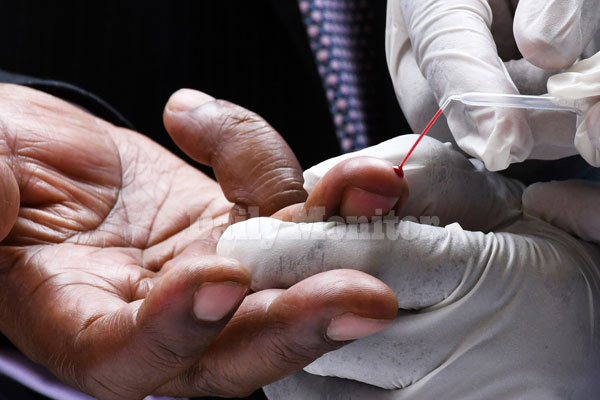Prime
Gene therapy brings hope to people with sickle cell, HIV

A doctor takes a blood sample from a patient
What you need to know:
- The treatment is administered once in a lifetime thus saving people the burden of taking drugs.
Gene and cell-based treatment is promising solutions for the control and cure of some chronic and life-threatening diseases such as sickle-cell disease (SCD), haemophilia, blood cancers, and HIV. Most of the current gene therapy clinical trials on SCD and HIV are conducted in North America.
The treatment is either by using someone else’s cells or those of the patient. Gene therapy, also called genetic engineering, involves getting one’s cells (a patient), improving them either by enhancing them to fight disease or as a replacement for the diseased cells and using them to treat the disease.
Unlike in agriculture where a lot of the genetic engineering is on seed, Dr Cissy Kityo, the executive director at Joint Clinical Research Centre (JCRC) says in medicine, the human seed (ova or sperm) or the embryo is not touched.
It’s not about engineering custom humans as this has no current ethical basis. “Therefore, it presents a new treatment paradigm,” Dr Kityo says.
Gene therapy is administered once in a lifetime. Therefore, for someone with HIV, that eliminates the burden of taking ARTs. It also has the potential to save the overall healthcare cost and increase the individual’s productivity.
Research is ongoing to ensure this treatment is effective, safe, and free from off-target effects and any contamination.
The process
Dr Francis Ssali, the deputy executive director in charge of clinical care and research at JCRC, says genetic modification involves a series of processes, the first of which is to collect specialised white blood cells called T-cells and blood-forming stem cells from the patient’s blood.
“These cells are then taken to a clean medical laboratory where they are counted, checked for viability, and purified. Thereafter, the gene to correct the disease is inserted into these cells and this is done by either using special enzymes called CRISPR or by the use of self-inactivating partial viruses called Lentiviral vectors. The lentiviral vector delivers the required gene into the cells without resulting in viral infection in the patient’s cells,” he says.
The process of introducing the corrective gene into the patient’s cell is called transduction and it can take between four to seven days to perform in the laboratory.
Once the cells have received this gene modification, they are checked for quality and safety before they are ready for reinfusion back into the patient.
In some instances, the patient is given medical treatment to enable them to receive the gene therapy cells,” he adds.
However, Dr Ssali says the current approaches to gene-therapy cell manufacturing are labour intensive and take a relatively long time to prepare, and require a large clean laboratory space.
“Thankfully, there are newer laboratory instruments that can automate this genetic engineering work in a single closed instrument, with efficiency,” he says.
Uganda has 1.4 million people living with HIV and 400,000 people living with sickle cells yet adherence to medicine is inconsistent for some.
Some HIV-resistant viral variants have emerged which threaten the efficacy of the treatment programme. As such, genetic engineering will be a blessing.
Globally, the first-generation cure trials for HIV were done, second-generation trials are coming up and there is hope that soon a short-term cure will be got.
Ugandan perspective
In Uganda, Dr Ssali says the hope is that by 2030, Uganda will have controlled HIV/Aids greatly and also contributed to finding a functional cure.
Dr Kityo says JCRC hopes to start HIV gene therapy trials in Uganda in 2024.
“The other focus is technology transfer where these gene therapy products are produced where they are needed, more efficiently, and more cost-effectively. That is why there will be more compact systems rather than the large labs,” she adds.
In Africa, Uganda ranks fifth among countries with sickle cell disease and whereas bone-marrow transplants can cure SCD, only 10 percent of the eligible patients can get a matched donor. Nonetheless, with gene therapy, this will not be an issue since the patient’s own cells are used.
Thankfully, the current gene therapy treatment technologies for HIV are the same used in sickle cell cure research.
“That is why preparing to address HIV also works to tackle the sickle cell disease,” Dr Kityo says.
The preparation
The joint Clinical Research Centre is working towards building the research teams and creating the necessary infrastructure for this novel research and clinical care. Arthur Makara, the coordinator of Uganda Biotechnology and Biosafety Consortium, calls for several partnerships because even when JCRC creates these technologies, they need help to mass produce them for a bigger population. Gene therapy only works on an individual, not on the sperm or ovary. Therefore, Dr Kityo says even after treatment, a sickle cell patient will still have sickle cell gene but normal cells in their marrow and live a normal life.





